Measurement of the polarization amplitudes in $B^0 \to J/\psi K^{*}(892)^0$ decays
[to restricted-access page]Information
LHCb-PAPER-2013-023
CERN-PH-EP-2013-104
arXiv:1307.2782 [PDF]
(Submitted on 10 Jul 2013)
Phys. Rev. D88 (2013) 052002
Inspire 1242126
Tools
Abstract
An analysis of the decay B0 -> J/psi K*(892)0 is presented using data, corresponding to an integrated luminosity of 1.0fb^-1, collected in pp collisions at a centre-of-mass energy of 7TeV with the LHCb detector. The polarisation amplitudes and the corresponding phases are measured to be |A_{\parallel}|^2 = 0.227 +- 0.004 (stat.) +- 0.011 (syst.), |A_{\perp}|^2 = 0.201 +- 0.004 (stat.) +- 0.008 (syst.), \delta_{\parallel} [rad] = -2.94 +- 0.02 (stat.) +- 0.03 (syst.), \delta_{\perp} [rad] = 2.94 +- 0.02 (stat.) +- 0.02 (syst.). Comparing B0 -> J/psi K*(892)0 and \bar{B}0 -> J/psi \bar{K}*(892)0 decays, no evidence for direct CP violation is found.
Figures and captions
|
Feynman diagrams contributing to $B^0 \rightarrow J/\psi K^{*0}$ decays. |
tree.pdf [45 KiB] HiDef png [49 KiB] Thumbnail [25 KiB] *.C file |

|
|
pengiun.pdf [45 KiB] HiDef png [124 KiB] Thumbnail [78 KiB] *.C file |
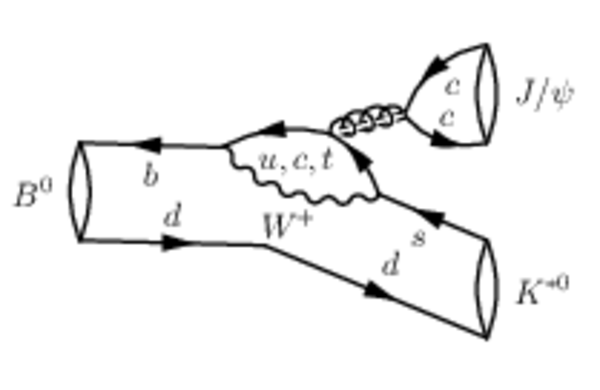
|
|
|
Definitions of the transversity angles $\theta, \psi, \varphi$, as described in the text. |
transA[..].pdf [27 KiB] HiDef png [20 KiB] Thumbnail [8 KiB] *.C file |

|
|
Invariant mass distribution of the selected $B^0\rightarrow J/\psi K^{*}{^0}$ candidates. The curves for the signal (solid blue), background (dashed red) and total (solid black) as determined from a fit are shown. |
MassNote.pdf [19 KiB] HiDef png [197 KiB] Thumbnail [173 KiB] *.C file |
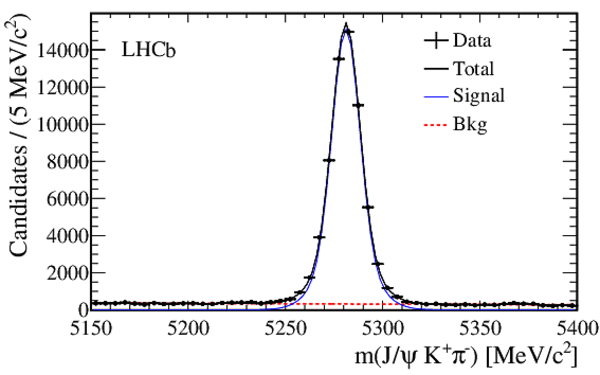
|
|
Angular acceptance $A(\Omega)$ as a function of each decay angle, integrated over the other two angles for (a) $\cos\theta$, (b) $\cos\psi$ and (c) $\varphi$. The projections are normalised such that their average value over the histogram range is unity. |
AccCos[..].pdf [14 KiB] HiDef png [72 KiB] Thumbnail [37 KiB] *.C file |
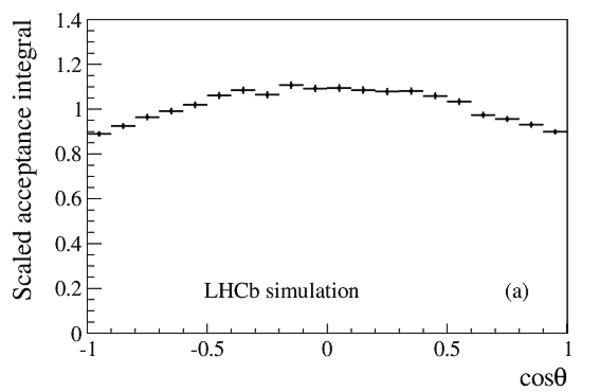
|
|
AccCos[..].pdf [14 KiB] HiDef png [72 KiB] Thumbnail [40 KiB] *.C file |

|
|
|
AccPhiNote.pdf [14 KiB] HiDef png [67 KiB] Thumbnail [37 KiB] *.C file |
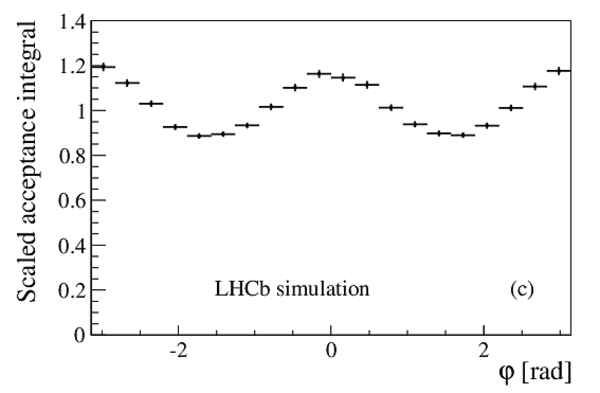
|
|
|
Background subtracted distribution of the $m(K^+\pi^-)$ invariant mass. The four bins used to resolve the ambiguity in the strong phases are shown. |
KstMass.pdf [17 KiB] HiDef png [134 KiB] Thumbnail [129 KiB] *.C file |

|
|
Projections of (a) the decay time and the transversity angles (b) $\cos\theta$, (c) $\cos\psi$ and (d) $\varphi$ from the fit to the data (points with statistical error bars). The different curves show the P-wave parity-even (dotted blue) and parity-odd (dashed blue) components, the pure S-wave (green) contributions without interference, as well as the total signal component (solid blue). |
TimePaper.pdf [19 KiB] HiDef png [168 KiB] Thumbnail [144 KiB] *.C file |
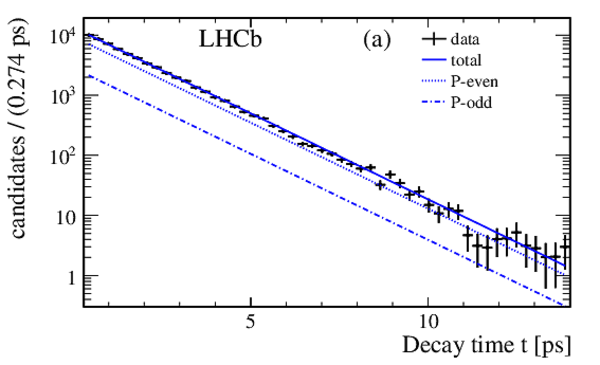
|
|
CosThe[..].pdf [16 KiB] HiDef png [168 KiB] Thumbnail [128 KiB] *.C file |
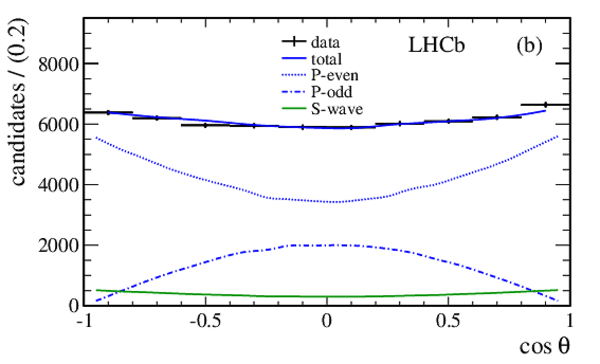
|
|
|
CosPsi[..].pdf [15 KiB] HiDef png [157 KiB] Thumbnail [124 KiB] *.C file |

|
|
|
PhiPaper.pdf [18 KiB] HiDef png [175 KiB] Thumbnail [134 KiB] *.C file |
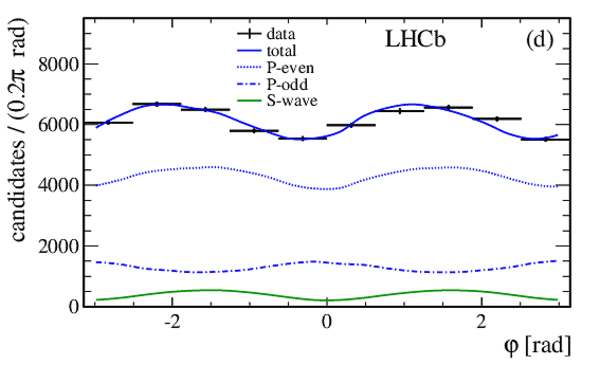
|
|
|
Variation of (a) $F_{\rm S}$ and (b) $\delta_{\rm S} - \delta_{\rm 0}$ in the simultaneous fit in four bins of the $K^+\pi^-$ mass. There are two solutions of the relative phase, the falling trend (solid points) being the physical one. |
As_syst.pdf [13 KiB] HiDef png [90 KiB] Thumbnail [92 KiB] *.C file |

|
|
Ds_syst.pdf [14 KiB] HiDef png [64 KiB] Thumbnail [40 KiB] *.C file |

|
|
|
Animated gif made out of all figures. |
PAPER-2013-023.gif Thumbnail |

|
Tables and captions
|
Definition of $h_k$ and $f_k$ appearing in Eq. 1. The $h_k$ factors are invariant under the phase transformation $(\delta_\parallel, \delta_\perp, \delta_{\rm S}) \longleftrightarrow (- \delta_\parallel, \pi - \delta_\perp, - \delta_{\rm S})$ [15,16]. The $f_k$ are functions defined such that their integrals over $\Omega$ are unity. |
Table_1.pdf [53 KiB] HiDef png [118 KiB] Thumbnail [57 KiB] tex code |

|
|
Bins of $m(K^+\pi^-)$ and the corresponding $C_{\rm SP}$ correction factor for the S-wave interference terms, assuming a uniform distribution for the non-resonant $K^+\pi^-$ contribution and a relativistic Breit-Wigner shape for decays via the $K^{*0}$ resonance. |
Table_2.pdf [36 KiB] HiDef png [91 KiB] Thumbnail [35 KiB] tex code |

|
|
Systematic uncertainties as described in the text. The contribution from omitting the $C_{\rm SP}$ factors is negligible for the P-wave parameters. The total systematic uncertainty is the sum in quadrature of the individual contributions. |
Table_3.pdf [50 KiB] HiDef png [42 KiB] Thumbnail [13 KiB] tex code |

|
|
Results for $B^0\rightarrow J/\psi K^{*0}$ candidates. The uncertainties are statistical and systematic, respectively. |
Table_4.pdf [42 KiB] HiDef png [73 KiB] Thumbnail [34 KiB] tex code |

|
|
Signal yield ($N_{ {sig}}$) and results for the S-wave parameters in each bin of $m(K^+\pi^-)$ mass, showing statistical and systematic uncertainties. Only the physical solution is shown for $\delta_{\mathrm{S}} -\delta_0$. |
Table_5.pdf [53 KiB] HiDef png [72 KiB] Thumbnail [34 KiB] tex code |

|
|
Correlation matrix for the four-bin fit. |
Table_6.pdf [40 KiB] HiDef png [62 KiB] Thumbnail [26 KiB] tex code |

|
|
Results from fits to the $B^0\rightarrow J/\psi K^{*0}$ and $\overline{B}^0\rightarrow J/\psi\overline K^{*0}$ background subtracted candidates and the direct $ C P$ asymmetries $\frac{\overline{X}-X}{\overline{X}+X}$, where $X$ represents the parameter in question. The uncertainties are statistical for the amplitudes and phases and both statistical and systematic for the direct $ C P$ measurements. |
Table_7.pdf [44 KiB] HiDef png [58 KiB] Thumbnail [27 KiB] tex code |

|
|
Comparison of the LHCb results assuming no S-wave component with results from previous experiments. The uncertainties are statistical and systematic, respectively. |
Table_8.pdf [43 KiB] HiDef png [49 KiB] Thumbnail [22 KiB] tex code |

|
Created on 27 April 2024.
